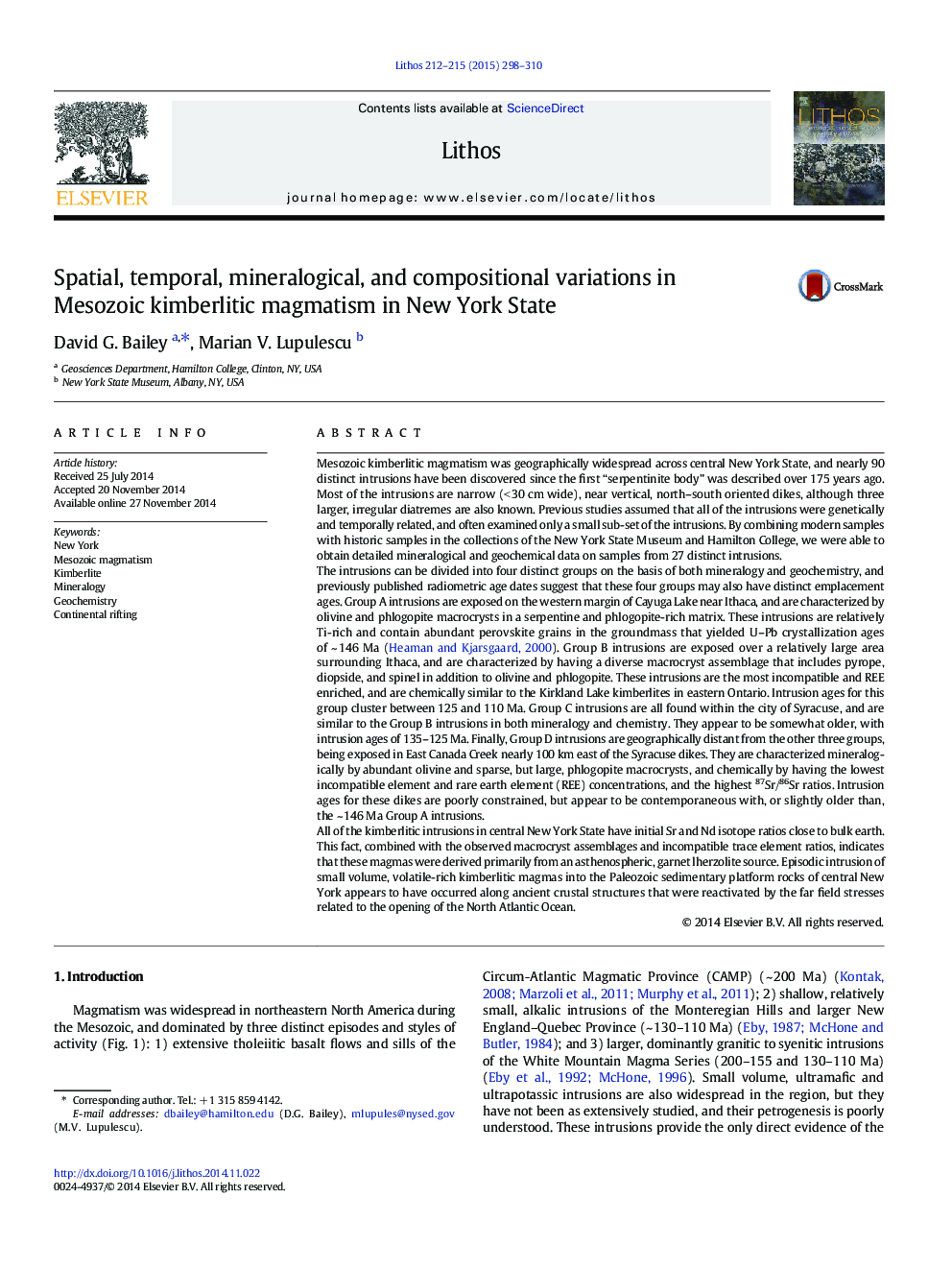| کد مقاله | کد نشریه | سال انتشار | مقاله انگلیسی | نسخه تمام متن |
|---|---|---|---|---|
| 4715802 | 1638669 | 2015 | 13 صفحه PDF | دانلود رایگان |
• Comprehensive overview of the mineralogy and chemistry of New York kimberlites
• Four distinct petrographic and geochemical groups identified
• Two distinct magmatic episodes recognized (110–130 Ma and 145–150 Ma)
• Trace elements and isotopes indicate an asthenospheric mantle source.
• Emplacement due to rifting related reactivation of ancient crustal structures.
Mesozoic kimberlitic magmatism was geographically widespread across central New York State, and nearly 90 distinct intrusions have been discovered since the first “serpentinite body” was described over 175 years ago. Most of the intrusions are narrow (< 30 cm wide), near vertical, north–south oriented dikes, although three larger, irregular diatremes are also known. Previous studies assumed that all of the intrusions were genetically and temporally related, and often examined only a small sub-set of the intrusions. By combining modern samples with historic samples in the collections of the New York State Museum and Hamilton College, we were able to obtain detailed mineralogical and geochemical data on samples from 27 distinct intrusions.The intrusions can be divided into four distinct groups on the basis of both mineralogy and geochemistry, and previously published radiometric age dates suggest that these four groups may also have distinct emplacement ages. Group A intrusions are exposed on the western margin of Cayuga Lake near Ithaca, and are characterized by olivine and phlogopite macrocrysts in a serpentine and phlogopite-rich matrix. These intrusions are relatively Ti-rich and contain abundant perovskite grains in the groundmass that yielded U–Pb crystallization ages of ~ 146 Ma (Heaman and Kjarsgaard, 2000). Group B intrusions are exposed over a relatively large area surrounding Ithaca, and are characterized by having a diverse macrocryst assemblage that includes pyrope, diopside, and spinel in addition to olivine and phlogopite. These intrusions are the most incompatible and REE enriched, and are chemically similar to the Kirkland Lake kimberlites in eastern Ontario. Intrusion ages for this group cluster between 125 and 110 Ma. Group C intrusions are all found within the city of Syracuse, and are similar to the Group B intrusions in both mineralogy and chemistry. They appear to be somewhat older, with intrusion ages of 135–125 Ma. Finally, Group D intrusions are geographically distant from the other three groups, being exposed in East Canada Creek nearly 100 km east of the Syracuse dikes. They are characterized mineralogically by abundant olivine and sparse, but large, phlogopite macrocrysts, and chemically by having the lowest incompatible element and rare earth element (REE) concentrations, and the highest 87Sr/86Sr ratios. Intrusion ages for these dikes are poorly constrained, but appear to be contemporaneous with, or slightly older than, the ~ 146 Ma Group A intrusions.All of the kimberlitic intrusions in central New York State have initial Sr and Nd isotope ratios close to bulk earth. This fact, combined with the observed macrocryst assemblages and incompatible trace element ratios, indicates that these magmas were derived primarily from an asthenospheric, garnet lherzolite source. Episodic intrusion of small volume, volatile-rich kimberlitic magmas into the Paleozoic sedimentary platform rocks of central New York appears to have occurred along ancient crustal structures that were reactivated by the far field stresses related to the opening of the North Atlantic Ocean.
Journal: Lithos - Volumes 212–215, January 2015, Pages 298–310
